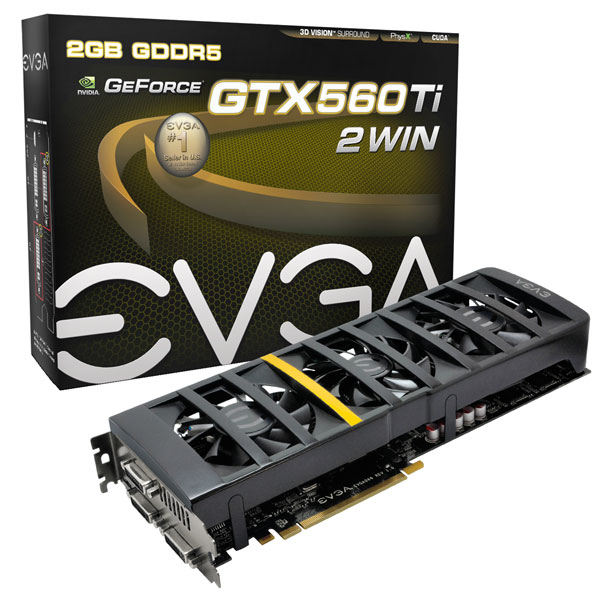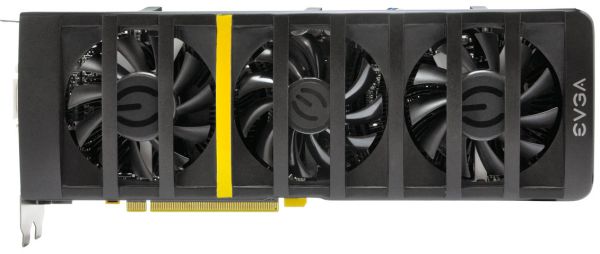The resulting product was the EVGA GeForce GTX 460 2Win, which combined 2 overclocked GTX 460s onto a single board. Unfortunately for EVGA, NVIDIA launched the GTX 560 Ti and its associated GF114 GPU mere weeks after CES 2011. GF104 was (and still is) a very capable GPU, but at the end of the day GF114 allowed the GTX 560 Ti to offer a 30% performance improvement for only a very slight increase in power consumption. The GTX 460 2Win did well enough for EVGA to continue with the design, but like the GTX 460 itself, it was clear that the 2Win design was never going to reach its full potential with GF104.
So now in November of 2011 EVGA is back with their next 2Win card: the EVGA GeForce GTX 560 Ti 2Win. Having replaced the GF104 GPUs with GF114 and tweaked the board to handle the extra power consumption, EVGA is giving it another shot. And this time they’re gunning for NVIDIA’s flagship single-GPU card, the GTX 580. Their proposition? For only a little more than the GTX 580 they can offer 30% better performance.
| EVGA GTX 560 Ti 2Win | GTX 580 | GTX 570 | GTX 560 Ti | |
| Stream Processors | 2 x 384 | 512 | 480 | 384 |
| Texture Address / Filtering | 2 x 64/64 | 64/64 | 60/60 | 64/64 |
| ROPs | 2 x 32 | 48 | 40 | 32 |
| Core Clock | 850MHz | 772MHz | 732MHz | 822MHz |
| Shader Clock | 1700MHz | 1544MHz | 1464MHz | 1644MHz |
| Memory Clock | 1002MHz (4008MHz data rate) GDDR5 | 1002MHz (4008MHz data rate) GDDR5 | 950MHz (3800MHz data rate) GDDR5 | 1002Mhz (4008MHz data rate) GDDR5 |
| Memory Bus Width | 2 x 256-bit | 384-bit | 320-bit | 256-bit |
| VRAM | 2 x 1GB | 1.5GB | 1.25GB | 1GB |
| FP64 | 1/12 FP32 | 1/8 FP32 | 1/8 FP32 | 1/12 FP32 |
| Transistor Count | 2 x 1.95B | 3B | 3B | 1.95B |
| Manufacturing Process | TSMC 40nm | TSMC 40nm | TSMC 40nm | TSMC 40nm |
| Price Point | $519 | $489 | $329 | $229 |
The 2Win on the other hand is exactly what it says on the label. Composed of 2 GF114 GPUs, the 2Win is a GTX 560 Ti SLI setup on a single card, with all of the specs and none of the compromises we see in ultra high end cards. In fact the 2Win is a factory overclocked card, if only slightly – its 850MHz core clock is a mild 3% higher than the 822MHz core clock of the baseline GTX 560 Ti, while the memory clock is identical at 1002MHz (4008MHz data rate). This is paired with 2GB of GDDR5, which is reduced to 1GB of effective VRAM due to the dual-GPU nature of the card.

But the real story here of course is the performance for the price. We’ve seen the performance of the GTX 560 Ti SLI in the past, and the performance is quite remarkable. For some time now a pair of NVIDIA’s mid-tier video cards in SLI have been able to surpass a single high-end card, and this performance is the basis of the 2Win. EVGA promotes the 2Win as being more than 30% faster than the GTX 580 and this is something that’s easily achieved in games where SLI scales well.
At the same time the 2Win is priced close to the GTX 580 to further cement its competitive status. EVGA has put the MSRP of the 2Win at $519, which is anywhere between $50 more expensive than the very cheapest GTX 580 to roughly the same price as factory overclocked models. Ostensibly this makes the 2Win more expensive than the GTX 580, but not significantly so given that we’re talking about the high-end video card market. Overall this puts the 2Win in a very good position versus the GTX 580, so long as it can deliver on its 30% performance claims over the GTX 580.
Next to its performance against the GTX 580, the other uses EVGA are using to promote the 2Win are the benefits derived from having multiple GPUs on a single card: namely NVIDIA Surround support. As with the GTX 590, by having 2 GPUs on a single card EVGA can team together the display outputs on the GPUs to drive up to 4 displays, versus 2 displays on a single GPU. This gives the 2Win the ability to drive a triple monitor surround setup on its own, and with 2 GTX 560 Ti GPUs should have the horsepower to do so in most cases. 3D Vision Surround is also a viable possibility thanks to the 3 DL-DVI ports, but the performance hit from 3D Vision is likely more than the 2Win can handle.
Ultimately the 2Win’s status as a multi-GPU card composed of GTX 560 Tis puts it in a unique place. Next to the GTX 580, its only other meaningful competitors are the Radeon HD 6950 CF, and the regular GTX 560 Ti in SLI. The bad news for the 2Win is that these are both cheaper options than the 2Win – you’re paying a price premium to get it on a single card.

No comments:
Post a Comment